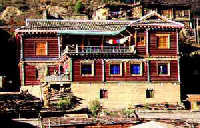Tibetan Houses
 Depending on the availability of the materials, Tibetan houses are built with more wood, for those living near forest, or more stones, for those living near mountains. Usually, the walls are one meter thick and built with stones. Theroofis built with scores of tree trunks, and then covered with a thick layer of clay. When it is finished, the roof is flat.
Depending on the availability of the materials, Tibetan houses are built with more wood, for those living near forest, or more stones, for those living near mountains. Usually, the walls are one meter thick and built with stones. Theroofis built with scores of tree trunks, and then covered with a thick layer of clay. When it is finished, the roof is flat.
In the valley area of Southwest China's Tibet Autonomous Region, the whole structure is like a castle with small windows as big as gun holes, no doubt, for defensive purposes.
In the city, there are big windows facing south to let sunlight in. The houses are one, two-, three-, or four-story high. For a single-floor house, sometimes a guarding wall is built around to keep animals in and outsiders out.
For a three-story house, the lowest level serves as a barn for animals or as a storage place; the second level as the human living quarters; and the third story as the worshiping hall or sometimes the grain bin. The stairs are outside the house and usually made of a single tree trunk from roof to roof. Once the ladders are withdrawn, the higher levels become inaccessible.
The living quarters contain living rooms as well as a kitchen with stoves and fireplaces. The common fuels are wood and dung. The furniture is painted in bright colors. The lavatory is usually at the highest part of the house as an extension; in this way, the house is clear of the smell of urine and feces.
The pastoral people sometimes build houses as home bases for the old folks and for storage. Otherwise, they usually enjoy a nomad life and live in tents. There are two kinds of tents in the pastoral area: black yak wool tents and white cloth tents.

 Farming areas and cities
Farming areas and cities Pastoral areas: tents
Pastoral areas: tents




